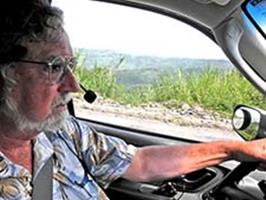Driving in Mexico
By Mexico Road Master, "Mexico" Mike Nelson
Driving in Mexico is much safer than you think. I’ve operated vehicles both on and off-road since 1968. I speak from experience. Many who say it’s unsafe have never gone or had a bad experience. I’ve driven in Los Angeles and Houston and had terrible experiences, but I don’t warn you not to drive in L.A. or Houston.

"Mexico" Mike Teaches us to "Enjoy The Drive"
Driving through Mexico’s scenic countryside is a dream that thousands of American tourists partake in every year. Thanks to the government’s massive infrastructure expenditure, Mexican roads are now safer than they’ve ever been. American drivers need to keep a watch on differences in local driving habits and conditions to avoid making mistakes. Driving in Mexico can be a lot of fun, but know the rules and the culture. On freeways and toll roads, driving is very similar to driving in the USA. You signal to pass and pull over to the ample shoulders in an emergency. Speed limits are posted in kilometers per hour. Some police in Mexico, similar to those at home highway patrol (Policia Federal de Caminos) have radar and enforce the posted speeds. In cities and on two-lane roads, the old Mexican rules of the road often still apply.
Driving in Mexico can seem daunting at first, but soon after you cross the border, you’ll realize that the similarities between both countries are more numerous than the differences. Nevertheless, understanding the local driving practices and conditions can save you a lot of trouble and ensure you only take good memories from your trip.
Driving in Mexico: Left Turns
Left Turns in the Cities
You cannot turn left on a green light in towns and cities. Most of the time, you must wait for a green arrow. The caveat “most of the time” is essential. Look at the traffic light. If four lights are on it, one is a left turn arrow. If there are only three, then there is no left turn arrow. One of the few tickets I got in Mexico was for not knowing this rule. I always look for those arrows today.
Left Turns on the Open Roads - Rural Mexico
On the open road, you should not turn left onto a crossroad. Please be sure to look for a pullout on the right side of the highway. This is an often unmarked semicircle exit across from a crossroads that allows you to pull over and turn ninety degrees until you can drive straight across the highway you were on. It is very logical. Instead of a car coming to a stop on a busy road waiting to make a left turn, it pulls out of the flow of traffic and safely turns when the coast is clear.
Left Turn Signals in Mexico
When a semi-truck in front of you puts on its left turn signal the driver is politely telling you that it is okay to pass him. Since he can see farther ahead than you, he’s helping you. This is the custom in Mexico.
BE AWARE
If you are driving the same highway, and are ready to pass the semi but you put on your left turn signal, does the driver behind you think you are signaling him/her to pass you? Most likely, they think you are telling them to go ahead. So be careful! Maybe don’t use the signal, just go but pay attention to your surrounding.
Left Turn Signals on Toll Roads
This does not apply on toll roads, where international rules of the road apply. On the open road (meaning libre two-lane highways), a left turn signal invites the car behind you to pass. Trucks and buses frequently turn their left blinker on to guide you around them. Sometimes, they have optimistic views of your acceleration capabilities. Don’t use your left turn signal on a two-lane road when you are about to pass. You might get hit. My advice — use your signals as you are used to on toll roads and in cities, but not the rural roads.
Road Markings and Lighting in Mexico
Road signs are present on most major roads in Mexico. However, driving at night or through provincial towns can be trickier since many aren’t lighted. Signs are only in Spanish and use the metric system, so you must understand these.
Driving in Mexico Under the Influence
Well, I’ve lived in Mexico and I have a lot of friends in Mexico. The dangers of alcohol reach far beyond making that decision to drive or not on any given day. The problem of drinking or using while operating a motor vehicle don’t stop at the border, its everywhere. From a legal perspective, it is against the law in Mexico to have ANY alcohol in your system while operating a vehicle. So please be wise and dont drink and drive as a tourist in Mexico. Article on Drinking and Driving Laws in Mexico.
Pedestrian Behavior on Mexican Roads
While Mexico has an excellent highway system, the presence of cyclists and pedestrians on free roads makes it more dangerous to drive. Most cyclists and pedestrians don’t wear any reflective clothing.
Turning Right on Red
After years of asking beat cops, my best answer for you is, “Probably.” Every cop has said, “Yes, in my town, but I don’t know about other towns.” The Highway Patrol won’t take a stand. I turn right on red. Or follow the local customs. It seems to work for me.
Right on red is usually OK, unless there is a sign saying that it is not. I have been told by many local people that it is legal. Cops across Mexico that I asked personally say, “Yes, in my town. But every town is different.” Occasionally a local honks at me if I wait for a green light. Today I turn unless I see a police officer.
RV Driving in Mexico
Thanks to Mexico’s interstate toll road system, crossing the country in an RV isn’t much different than in America — although it’s costlier. There are plenty of RV parks on Mexico’s Pacific Coast and some on the Gulf Coast and Yucatan. Baja, Sonora, Jalisco – so many great places to drive your RV. Check out my Mexico RV page and guides index here.
Here is an article I dedicated exclusively to Driving an RV in Mexico.
Driving in the City
New Yorkers might feel at ease in Mexico City‘s noisy streets but should still focus on some key differences. In Mexico, one-way street markings tend to be 10 feet high and are only about 5 inches tall. The right-of-way is signaled using a green arrow, so streets going in the direction of the red arrow must yield. Intersections are tricky because, although left turns have 4-light traffic signals and left-turn lanes like in America, right turns on red are familiar even though they’re illegal. In Mexico City check the No Hay Circula article for information on circulation restrictions.
Highway Driving in Mexico
The most significant cause of road accidents among American tourists is the narrow roadways with almost no shoulders. Unlike American 4-lane roads with broad shoulders, in most Mexican roads (even toll roads), the pavement and the shoulder are separated by several inches, so if your right side wheels drop off the pavement, it will most likely send the vehicle rolling over.
Speed Bumps - "Topes"
Speed bumps are called topes in Mexico, and they are huge and everywhere. You’ll often see yellow signs with two black bumps warning that a tope lies ahead. Although, in rural areas, some can be hand-written by the same residents of the region.
Military Checkpoints and Blockades
The Mexican military often sets checkpoints on major highways, outside major cities, and near the border. Some are static, although many are set randomly. They’re no more than a nuisance but show how important it is always to carry your passport, visa, driving license, and proof of insurance with you. Blockades are a different animal. Check this article for more information on Mexico Road Blockades. (More information can be found here.)
Rural Roads in Mexico
On freeways and toll roads, driving in Mexico is similar to driving in the USA. You’ll need to pass and pull over to the ample shoulders in an emergency. Speed limits are posted in kilometers per hour. Some police in Mexico, similar to those at home, have radar and enforce the posted speeds.
Rural roads represent a unique experience to see the countryside, both in Mexico and the US. However, unlike in the USA, few roads running through Mexican ranchos have fences fitted on either side that would restrict the movement of cows, sheep, horses, and other animals.
Driving in Mexico - AT NIGHT?
Don’t drive at night on the two-lane roads. There is a lot of loose livestock, and I have yet to see a cow equipped with tail lights. My tip for driving at night is: DON’T. On the toll roads (which are as good as or even better than those in the U.S. or Canada), I have relaxed my stance on night driving. So, if you are sticking to the toll roads, you could drive an hour or so after dark. However, although operating in Mexico is generally safe, remember that bad people like to move under the cover of darkness in any country.
Driving in Mexico - Conclusion
These are the most critical quirks of driving in Mexico. Learn these, and you will have a safe trip. Most importantly, leave your aggressive driving habits at home. As one U.S. bus driver told me after a week in Mexico, “I can’t believe how courteous Mexican drivers are. They look out for each other.”
RV’s generally should stay one lane over but never in the far right lane. Work your way to your exit long before you would in the States. Mexican highway signs will give you way too much warning or none. (Read more about driving RV’s in Mexico here.)
Motorcyclists face a few additional challenges to safely riding in Mexico. While you may already do this in the USA or Canada, be extra cautious if it starts to rain on a Mexican highway. An extra layer of oil or diesel slick seems to be on the roads. The first ten to 20 minutes is the worst. Hole up under an overpass if you’re not near civilization.
INSURANCE NOTE
Even if your US or Canadian insurance covers medical or theft of your car in Mexico, they cannot cover your liability. It must be from a Mexican company. It is the law to carry liability insurance from a Mexican company at a minimum.
Granted, the fines are small for not having insurance, but do you want to give the police an excuse to hassle you? If you don’t believe me, ask your agent. If you have one of those companies that extends limited coverage in Mexico, you will at least need a liability-only Mexican car insurance policy.
I use Mexico Insurance Services for their online system. They offer only the best and take it seriously. I looked into some of the other online brokers and they are either ivy league jerks or nothing more than influencers with a insurance license. Don’t get me wrong I like surfers and off-roaders, but I am not going to buy insurance from them. This stuff is serious, especially in Mexico. Their link is mexinsurance.com. I don’t get any commission for referring them, I just truly believe they will serve you the best.
Driving in Mexico - Frequently Asked Questions
What the biggest difference in driving in Mexico vs US?
The biggest difference has to be the turn signals. When you use the left signal in Mexico it’s to signal the person behind you that it’s ok and clear to pass. This comes from Truckers who sit higher, and can see further up the road than you. They will signal to let you know it’s OK to pass. This is also used by normal commuter vehicles as well.
How can you convert speed KM to MPH?
110 KMH
=
68 MPH
100 KMH
=
62 MPH
80 KMH
=
49 MPH
60 KMH
=
37 MPH
50 KMH
=
31 MPH
40 KMH
=
25 MPH
20 KMH
=
12 MPH
10 KMH
=
6 MPH
Can you turn right on red in Mexico?
No, but yes. Local police say it’s OK, and certainly the locals get upset if you wait for it to turn green. But the law says stay put until you get the green light.
What are Blockades and Road Blocks?
Usually run by the government or police officials to check for passports, ID’s and insurance.
What is the legal alcohol limit in Mexico?
The legal limit for a tourist is 0.0%. It is illegal to have any alcohol or drugs in your system while you operate on Mexican roads. And if they smell alcohol or weed in your vehicle, you’re just asking for trouble. Don’t do it.



